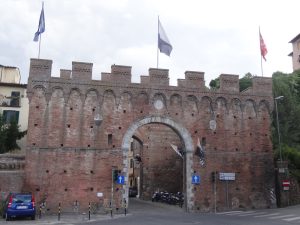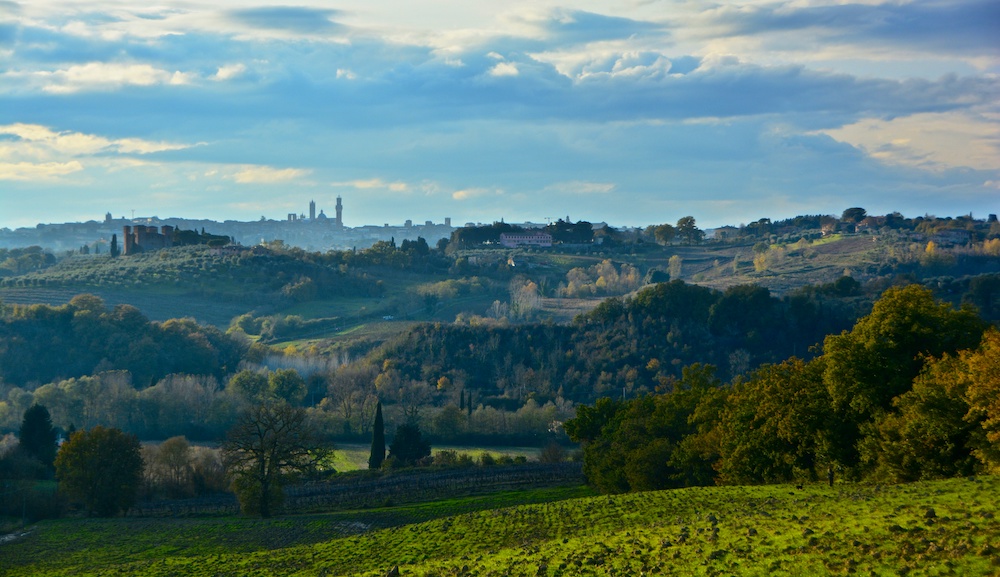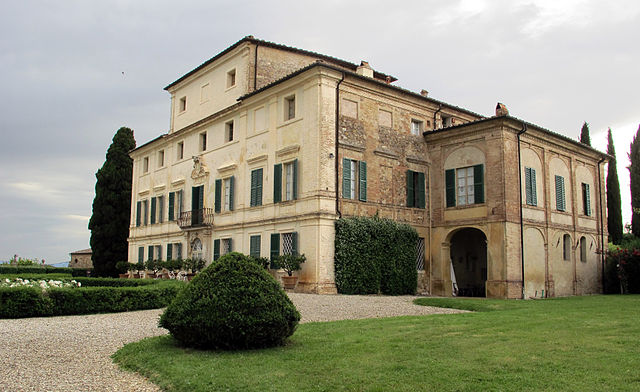7.6 In the heart of Chianti
Via Vallerozzi looked like a staircase of broad roofs all the way to the historic Rocca dei Salimbeni, the spur of which was covered by the black shadow of a smaller fir tree. Beyond this fortress, who knows where, was the top of the Tower; and further away, the dome of the Madonna di Provenzano, almost enclosed within another expanse of houses. While the roofs of the three streets, which intertwined at Porta Ovile, sloped down, all leaning to one side; as if the houses could not stand up straight.
(F. Tozzi, Con gli Occhi Chiusi)
‘A unique work of art, unparalleled in our western world.’ We do not know if what Guido Piovene wrote about Siena is hyperbole. Certainly, however, when you travel along the road that leads from Porta Ovile to Porta Pispini, you will be struck by the views of the city, which, although seemingly confined within the last ring of defensive walls, rises majestically above the surrounding countryside.

Ⓒcredit Jordiferrer
Once past Porta Pispini, ride downhill along Via Aretina until you reach the valley floor at Due Ponti. From here, take Strada di Pieve al Bozzone, which is a series of uphill and downhill stretches for a few kilometres. Then, where the dirt track begins, the route gradually climbs. It is lined with masterfully restored farmhouses, a few manor houses, and an occasional dilapidated farmhouse, evidence of a bygone world that, in the mid-20th century, made the difficult decision to leave the countryside for the city.
Once back on the asphalt road, turn left and then immediately turn right in the direction of Pievasciata. This is a beautiful road that maintains a high elevation with panoramic views of both Siena and the first Chianti hills that reflect wonder and bliss. Here, you find a geometric alternation of cultivated and wooded areas that give the panorama the characteristic feature of this land, the home of wine and oil.
Crossing the junction that leads to Geggiano (with its beautiful Villa Bianchi Bandinelli), you pass the village of Catignano, now a tourist resort, and the diversion that indicates the Ruderi del Castello di Cerreto. Proceeding slightly uphill, you come to the small village of Pievasciata, where the Pieve di San Giovanni Battista, clearly Romanesque in style, is worth a visit. It’s now time for a break.
Pievasciata marked the border between the territories of Siena and Florence; a recent study by Carlo Bellugi postulated the (not insignificant) possibility that the Battle of Montaperti was fought more in Pievasciata than on the hill where the memorial stone of the event stands in Montaperti. What is certain, though, is that on the evening of the 3rd of September 1260, the Guelphs were camped here, and so it is possible that the battle may have begun in this area and ended at Montaperti.
As it happens, Pievasciata is steeped in the history of the Sienese territory and the sight of a building like the pieve of the same name in such a poor state of neglect, despite being located in such a fine area of the province, is not good for the spirit. (It is private property, though.)
We are, in fact, in the heart of the Chianti Classico Gallo Nero production area, straddling the municipalities of Castelnuovo Berardenga and Gaiole in Chianti.
You should head in the direction of Vagliagli and the Parco Sculture del Chianti (Chianti Sculpture Park), a unique and prestigious permanent open-air exhibition filled with contemporary sculptures. The park, inaugurated in 2004, is home to 26 installations by internationally acclaimed artists from the five continents who have put their creativity and style to the test by inserting their unusual and impressive creations in such an evocative landscape. The visitor, immersed in a splendid natural environment, can encounter works of art made of such diverse materials as iron, bronze, granite, marble, and glass, and admire their unique and harmonious effect.
The road now becomes a dirt track and climbs lazily to the junction indicating ‘Pieve a Bozzone’. The land is breathtakingly beautiful, and the views stretch eastwards to beyond the Monti del Chianti, up the hills and down to the valley floor, in a glorious display of olive groves and vineyards. Cycling slowly and with spiritual intensity, you realise why the Chianti region is so popular. It’s not just for its wine; here and there the area is dotted with castles, houses that were once farmhouses but have now been renovated with absolute mastery, aziende agrituristiche (holiday farms), and tiny villages linked together by a network of dirt roads that wind their way through every corner and along which the language of local devotion manifests itself curve after curve with small oratories, small churches, wooden crosses, tabernacles, and Madonnas. A religiosity born of a society of ‘ordinary men and women’ who inhabited a hardscrabble land that, until a few decades ago, was ‘far away’ and closed in on itself.
Continue along the dirt road as far as the ancient castle of Borgo Scopeto, marked by a road sign, which today is a renowned relais and winery, and then continue downhill towards the hamlet of Santa Margherita-La Suvera and on to Pieve al Bozzone. Siena is now just a few kilometres away.
Porta Ovile
Documents dating back to the beginning of the 13th century mention a Porta di Ovile, although it was almost certainly an entrance that must have been higher up than the present one, which, for its part, must have been built to protect the Ovile valley. Between 1231 and 1246, specific references are made to a ‘new gate from the plain of the Ovile spring’. By order of the General Council, concerned by the signs of war emanating from Florence, the gate was repeatedly fortified, reinforced, and armed the middle of the century, as was its ravelin, with which it had already been equipped; in 1258, it was also closed with beams and planks. The arch is rounded, and the front of the entrance bears the coats of arms of the Balzana, the ‘Leone del Popolo’ (Lion of the People), and the monogram of San Bernardino. The existing antemural, on the other hand, dates back to the 15th century. In 1929, the narrowing under the inner arch was eliminated as it was particularly inconvenient for the passage of public buses.
The Villa of Geggiano, the Castello di Cerreto, the Pieve di San Giovanni Battista a Pievasciata.
Both the Villa di Geggiano, owned by the Bianchi Bandinelli family since 1527 and dating back to at least the 13thcentury, and the precious garden owe their current appearance to a renovation in the second half of the 18th century. Declared a national monument, the two form a unique historical and scenic complex owing to the systematic preservation of furnishings and decorations that take the visitor back to the atmosphere of an elegant 18th-century holiday home. Some of the rooms in the villa still have their original ‘rustic Venetian’ furnishings, with ornamental motifs taken from Carte de France and Toile de Jouy fabrics covering the walls. In the garden, amidst centuries-old cypresses, boxwood hedges, and hundred-year-old potted lemon trees, there is an open-air theatre, or ‘di verzura’, with two prosceniums adorned with statues, an idyllic setting for classical music concerts. Geggiano was the set used by Bernardo Bertolucci for the well-known film ‘Io Ballo da Sola’ and by other international productions for TV dramas, commercials, and fashion shoots.
A completely different atmosphere awaits you when you arrive at the Cerretaccio site. The entrance with its stone archway, once the main entrance to the castle of Cerreto Ciampoli, dating back to 1087, is striking. For centuries, with varying fortunes, it defended the borders of the Republic of Siena in this area (conquered in 1232 by the Florentine army, it came back into the possession of Siena in 1348). Given its position, Cerretaccio was also a place of refuge for brigands and Sienese exiles, and was subsequently destroyed by Siena itself in the first half of the 16th century. The transformation of the complex into a true fortress is still evident today. The tower of the keep, even after its demolition, allows a glimpse of the foundations and the large chunks that have fallen to the ground, making it one of the most evocative views of the castle. The importance of the fortification is also attested to by a second set of walls on which a flight of stone stairs built to access the road carved into the rock face along the north side of the complex is grafted.

ⒸAntonio Cinotti
The Pieve di San Giovanni Battista a Pievasciata is a real surprise for visitors. The Romanesque façade is also characterised by the presence of a tower, which gives it a particular appearance. Stepping through the door is like crossing the threshold of time, because while the exterior, with its severe grandeur, is in excellent condition, the interior has nearly collapsed. Nevertheless, it is clear that the church must have originally had more than one nave; you can still see the 18th-century Baroque altars and the walls completely frescoed with geometric designs in bright red. Of what remains after its abandonment, it is worth noting a life-size Madonna and Child, an angel guiding the Child by the hand, the majestic and decorated wooden pulpit on the left wall and, in the vault, polychrome, gilded decorations in imitation of late antiquity and early medieval art. The building and the remnants of what adorned it bear witness to a place of worship that was popular and loved by those who frequented it.
The adjacent rooms of the pievania, which housed the rectory, allude to a dimension of contiguity between ‘ordinary’ daily life and spiritual life. In the passageway leading to the houses of those who lived within the ring of walls inside the pieve, there is an oven that still seems to give off the smell of bread being baked, of meat being cooked, of the daily routine of a place that was as mystical as it was alive. In the courtyard there is even a very small dwelling, clearly the kennel of a dog, adorned with a cross.

ⒸSaliko
The name Pievasciata, given to what is one of Berardenga’s oldest seats of worship, dates back to 1086 and is a contraction of Plebs Sciatae, where ‘sciata’ could almost certainly be a derivation of ‘ischiata’, from Ischia, ‘iscla’, which is a corruption of ‘insula’. But what is an island doing in the middle of the Chianti landscape? In this case, island does not mean emerged land in the middle of the sea, but land that remains dry during the flooding of a nearby river (for example, Isola d’Arbia and Ischia d’Ombrone). And this is where you are now, in the realm of the Arbia and its related waterways.
CHIANTI, THE EROICA, AND UNPAVED ROADS
Vintage bikes and Chianti. Strade bianche (unpaved roads) and Chianti. The charm of ‘old-time cycling’ and Chianti. The Eroica was born in Gaiole in Chianti in 1997 owing to the desire of its founder, Giancarlo Brocci, and a few other idealists who wanted to combine the love of cycling with a culture that highlights genuine issues and content, based on the preservation and enhancement of unpaved roads as an identity, not to be taken for granted, for an athletic event free from competition.
The Eroica immediately became a strong feature of Chianti and, more generally, of the Sienese area, adopting a culture aimed at preserving and valorising a land so well enhanced by cycling tourism. Today it is possible to claim that this gamble paid off. The Eroica has been so successful that it has given birth to countless ‘Eroiche’ in the most diverse corners of the world and a world tour cycling race—the Strade Bianche —which is ridden in March and has established itself worldwide as the ‘northernmost classic in southern Europe’.
Borgo Scopeto

ⒸLigaDue
Borgo Scopeto, like many settlements in the area, dates back to the year 1000. Its name derives from the abundant presence of Erica scoparia (green heather). Originally a fortification built by Siena as a defence against possible sieges, it was conquered by the Florentines during the period of the wars between Siena and Florence.
From the 14th to the 19thcenturies, it was owned by the Sozzini family, a noble reformist Sienese dynasty (suffice it to mention its most famous members, the theologians Alessandro and Fausto), who transformed it into a castle. Over time, other structures were added to the main tower, such as the manor house, the stables, the farmers’ houses, the chapel, and the wine cellar, transforming the property into a true village and flourishing farm devoted to the cultivation of grapes and olives. In the 17th century, a garden—called Roccolo—was created for the training of falcons.